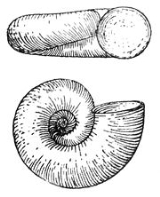
Valvatidae
Encyclopedia
Valvatidae, the valve snails, is a taxonomic family
of very small freshwater snail
s with an operculum
, aquatic
gastropod mollusks.
", itself belonging to the clade
Heterobranchia
(according to the taxonomy of the Gastropoda by Bouchet & Rocroi, 2005
).
The family Valvatidae has no subfamilies (according to the taxonomy of the Gastropoda by Bouchet & Rocroi, 2005
).
is Valvata O.F. Müller
, 1774.
Genera in the family Valvatidae include:
as biological indicators. According to the Biological monitoring working party
they have a score of 3, which means that they have quite a high tolerance to pollutant
s.
Family (biology)
In biological classification, family is* a taxonomic rank. Other well-known ranks are life, domain, kingdom, phylum, class, order, genus, and species, with family fitting between order and genus. As for the other well-known ranks, there is the option of an immediately lower rank, indicated by the...
of very small freshwater snail
Freshwater snail
A freshwater snail is one kind of freshwater mollusc, the other kind being freshwater clams and mussels, i.e. freshwater bivalves. Specifically a freshwater snail is a gastropod that lives in a watery non-marine habitat. The majority of freshwater gastropods have a shell, with very few exceptions....
s with an operculum
Operculum (gastropod)
The operculum, meaning little lid, is a corneous or calcareous anatomical structure which exists in many groups of sea snails and freshwater snails, and also in a few groups of land snails...
, aquatic
Aquatic animal
An aquatic animal is an animal, either vertebrate or invertebrate, which lives in water for most or all of its life. It may breathe air or extract its oxygen from that dissolved in water through specialised organs called gills, or directly through its skin. Natural environments and the animals that...
gastropod mollusks.
Taxonomy
The Valvatidae family is classified within the informal group "Lower HeterobranchiaLower Heterobranchia
Lower Heterobranchia, also known as the Allogastropoda, is a group of rather specialized, highly-evolved sea slugs and sea snails, within the clade Heterobranchia...
", itself belonging to the clade
Clade
A clade is a group consisting of a species and all its descendants. In the terms of biological systematics, a clade is a single "branch" on the "tree of life". The idea that such a "natural group" of organisms should be grouped together and given a taxonomic name is central to biological...
Heterobranchia
Heterobranchia
Heterobranchia, the heterobranchs or Euthyneura, is a taxonomic clade of snails and slugs, which includes species from the sea, the land and freshwater; marine, aquatic and terrestrial gastropod mollusks....
(according to the taxonomy of the Gastropoda by Bouchet & Rocroi, 2005
Taxonomy of the Gastropoda (Bouchet & Rocroi, 2005)
The taxonomy of the Gastropoda as it was revised by Philippe Bouchet and Jean-Pierre Rocroi is currently the most up-to-date overall system for classifying gastropod mollusks...
).
The family Valvatidae has no subfamilies (according to the taxonomy of the Gastropoda by Bouchet & Rocroi, 2005
Taxonomy of the Gastropoda (Bouchet & Rocroi, 2005)
The taxonomy of the Gastropoda as it was revised by Philippe Bouchet and Jean-Pierre Rocroi is currently the most up-to-date overall system for classifying gastropod mollusks...
).
Genera
The type genusType genus
In biological classification, a type genus is a representative genus, as with regard to a biological family. The term and concept is used much more often and much more formally in zoology than it is in botany, and the definition is dependent on the nomenclatural Code that applies:* In zoological...
is Valvata O.F. Müller
Otto Friedrich Müller
Otto Friedrich Müller, also Mueller was a Danish naturalist.-Biography:Müller was born in Copenhagen. He was educated for the church, became tutor to a young nobleman, and after several years' travel with him settled in Copenhagen in 1767, and married a lady of wealth.His first important works,...
, 1774.
Genera in the family Valvatidae include:
- Andrussovia Brusina, 1903
- BorystheniaBorystheniaBorysthenia is a genus of small freshwater snails with an operculum, aquatic gastropod mollusks in the family Valvatidae, the valve snails.The aperture of Borysthenia is not circular...
Lindholm, 1933 - Costovalvata Polinski, 1932
- Liratina Lindholm, 1906
- Megalovalvata Lindholm, 1906
- ValvataValvataValvata is a genus of very small freshwater snails with an operculum, aquatic gastropod mollusks in the family Valvatidae, the valve snails.-Species:The type species for this genus is Valvata cristata O.F. Müller, 1774....
Müller, 1774- Cincinna Hübner, 1810 - It is recognized either as genus of a subgenus of Valvata.
Ecology
Snails in the family Valvatidae are useful for measuring water qualityWater quality
Water quality is the physical, chemical and biological characteristics of water. It is a measure of the condition of water relative to the requirements of one or more biotic species and or to any human need or purpose. It is most frequently used by reference to a set of standards against which...
as biological indicators. According to the Biological monitoring working party
Biological monitoring working party
The biological monitoring working party is a procedure for measuring water quality using species of macroinvertebrates as biological indicators....
they have a score of 3, which means that they have quite a high tolerance to pollutant
Pollutant
A pollutant is a waste material that pollutes air, water or soil, and is the cause of pollution.Three factors determine the severity of a pollutant: its chemical nature, its concentration and its persistence. Some pollutants are biodegradable and therefore will not persist in the environment in the...
s.
Further reading
- Hannibal H. (1910). Valvatidae of the Western North America. The Nautilus, page 104-107.

